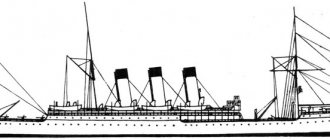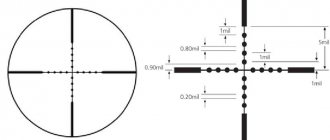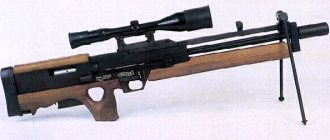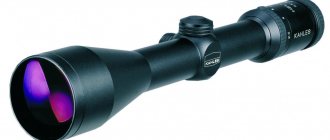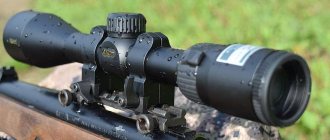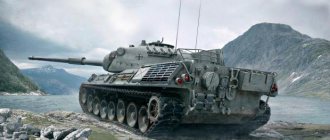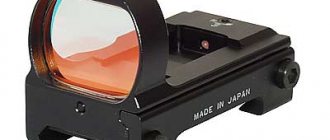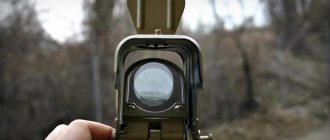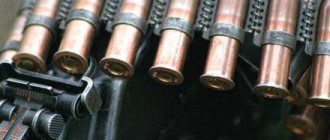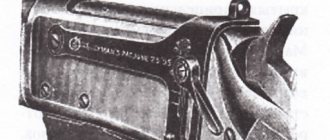Escape from Tarkov: guide to sniper scopes. Part II: determining the distance in thousandths, conclusions for all sights
Let's move on to the next method of determining distance using sights. We will use domestic ones using thousandth scales. There is a formula here too, and fortunately it works quite well, and the sights do not behave strangely in calculations.
1000 x target size (0.5 m)/divided by the number of thousandths.
Since thousandths are an angle, horizontals are more often determined, so the width of the chest is taken as a goal - 0.5 meters. Fortunately, we only have 2 sniper scopes for rings, because we are not considering PSU today, and the tests should be simpler.
Tests
Let's start with the most controversial sight - Pilade 432. Its aiming reticle seems completely uninformative and is called a “cross”. However, each side of this “cross” takes up 0.005.
- At a distance of 163 meters, according to the formula, we take 0.003 and get 167 meters, which is very close.
The second sniper scope for thousands is the 1P59 or 1P69 Hyperon complex.
- In a multiple of 3x we have at 0.002 and 0.006 - 192 meters, and in a multiple of 10x 0.003 - 167 meters.
Let's move to a distance of 261 meters. With Pylades we have approximately 0.002 and a formula for 250 meters, with Hyperon at 3x - 0.001 and a calculation for 312 meters and with 10 times - 0.0002 we get the same 250 meters.
During these tests, it became clear that it is now not possible for us to measure the distance from a hyper at a magnification of 3x accurately, because the measuring scale must be adjusted to the magnification mode. This is one of the features of using the first focal plane. That is, the 3x and 10x multiples are correct, but in the 3x multiple the measurement scale should be smaller than it is now. In addition, when calculating thousandths with the help of Hyperon sights in a multiple of 10x, you can determine tenths of thousandths.
With Pilade, it’s still done almost by eye, and in principle it’s possible to measure distances up to 500 meters, although there are practically no distances above 500 meters in the game.
So, above we covered the theory of determining range using the mil-dot grid and the thousandths formula. We found out that these are working methods, but some of our sights do not work quite right. Somewhere the magnification is incorrectly indicated, somewhere the reticle is larger than necessary.
Shooting at existing sight markers
This topic is not easy and took a lot of time and testing. The system will be as follows: we will name the sight and at what reticle pitch its firing distance is set.
- The Burris FullField TAC-30 scope has mil-dots in 200-meter increments. Works in both 1x and 4x magnification.
- In EOTech Vudu at single magnification it is not possible to find out the exact distance markers, but at 6x magnification each cut of a mil-dot takes 100 meters. Most likely, this is why many people choose this scope, as it intuitively reads the reticle.
- The Hensoldt FF 4-16 scope in 4x magnification has each dot of 125 meters, in 16x mode each dot is 25 meters. There is also a correction scale, which is very similar to the PSO 1 scale. But if it works in the PSO, here it has more of a decorative appearance, and it is simply not possible to determine the exact distance to the target.
- March Tactical scope. Each mil-dot point is 50 meters.
- Leupold Mark 4 scope. Each mil-dot is also 50 meters, which once again confirms the theory that the magnification is the same with the Leupold Mark 4 scope at 14x.
- Nightforce ATACR. Each mil-dot at 13x is 50 meters, and at 20x it is also 50 meters.
- Pylades 432. Shooting at the bottom of the cross takes place at a distance of 300 meters.
- Hyperon. Each tick has 400 meters. Shooting at the lower wings of the first tick, a distance of 200 meters. There is also a correction scale at the top for 400 and 800 meters. We don’t have such ranges in normal visibility in the game, so there’s no point in using them.
CONTENT:
- Automated sight-rangefinder "Lynx - LD"
- Tactical and technical characteristics of the rangefinder sight Lynx - LD
- Tactical and technical characteristics of the 1P63 sight
- Tactical and technical characteristics of 1PN91
- Tactical and technical characteristics of 1PN101
- Tactical and technical characteristics of 1PN110 / 1PN113
- Tactical and technical characteristics of PGO-7V
- Tactical technical characteristics of the 1P76 sight
- Tactical technical characteristics of the Hyperon sniper pancratic sight
- Tactical technical characteristics of 1P77
- Tactical technical characteristics of 1P78
- Tactical technical characteristics of 1P65
- Tactical and technical characteristics of 1PN100
- Tactical and technical characteristics of SPP / SPP-M
- Tactical and technical characteristics of 1PN116
- Tactical and technical characteristics of USP-1
Scope utility scale
Now all that remains is to sum it up - which sniper optical sights are the most convenient, versatile and functional. On the one hand, this question is quite subjective, because a specific top can be influenced, for example, by personal experience in using this or that optics.
On the other hand, we have actual tests, where it is approximately clear what each scope is capable of.
Let's start in order with less multiple optics and build a scale of optical magnification.
Tactical 30
It has a variable multiplicity, at which there are constant mil-dot designations. Using it, you can determine the distance with an error of up to 10%, but the optimal working distance with it is up to 200 meters.
Although it’s funny that you can use it to make a shot a kilometer away. The sight is good, but it fell a little short of the mark.
Pilade 432
A very specific sight and the most common sight is the VPO 215 Ermine. The operating range of a particular rifle is 150-200 meters maximum, and the sight itself provides this perfectly.
With Pylade you can determine the distance to the target, but the exact distance can only be determined if you are an attentive player. The Pilade 432 is not the most convenient sight for shooting without adjustments. We would define its category as “not bad”.
EOTech Vudu
Remains one of the most commonly used sniper scopes. Easy to handle, intuitive cutting, 6x aiming, very close to the eye, making 6x almost like 10x. A fairly well-functioning system for determining the range to a target. These are strong advantages.
In our opinion, aiming at 1x is not the most convenient, but it’s not that it’s important for a sniper. This scope is definitely meta.
Hensoldt FF 4-16
For us personally, this is our favorite among long-range optics. Nice 4x magnification for distances up to 200 meters and 16x for any possible distance. A working system for determining target distance at 16x and not quite working at 4x. The shooting distance with the adjustment set to 16x is about 500 meters.
But when shooting with 4x it goes beyond 1 kilometer. Still, this is not a simple sight, but those who love high-power optics should appreciate it. For us personally, it's meta, but it's just a good scope.
Hyperon
It’s really a dark horse and few people use it, because the sight is domestic with a strange aiming scale. Although the developers just have to adjust the reticle scale by 3x, and the sight will be the most accurate in determining the distance to the target. Variable magnification accompanies the use of Hyperon for shooting at a distance from 100 to 300 meters freely. The sighting range of the optics is 1200 meters, which is very excessive for Tarkov.
But the sight has some drawbacks: it is bulky. However, its close position to the observer's eye is comparable to a VUDU scope.
Today we did not touch upon the issue of price, because the price tag for sights always changes: some sights are needed for quests, some are simply rare. But nothing like that can be said about Hyperon. It's no joke, you can collect it for 20,000 immediately after the wipe. It is not clear why this sight is not considered meta, because in fact it is.
March Tactical
The oldest optics in our game. A veteran few have ever loved. Previously, it came in the starter pack after the wipe, and it was an easy 30K. In the raid, we saw these optics only a couple of times on the enemy.
But despite this, the sight can be a good help in determining the distance to the target. However, there is a relatively large error above 10%. It is convenient for shooting mil-dot cuts - the pitch is 50 meters. If you know the distance, then you can work comfortably. Although comfort is a relative concept, because there is no variable magnification, and it is located quite far from the eye.
The maximum working distance with it is 600 meters, which we practically never have. We have no illusions about this scope, and even though it works, we would put it up for sale. But it has advantages that still make it “inconvenient” at most.
Leupold Mark 4
The optics are broken in terms of magnification, which in fact are 14x, not 20. It can provide good information about the distance to the target, but working with it at a distance below 200 meters makes it not a very comfortable everyday choice. But a good choice for real snipers.
Also, a step of 50 meters per mil-dot is convenient. But having a quest to complete the assassination of a navigator with this scope is the saddest thing we can get. In fact, this sight can only be used at two points in the forest location. Both of these points are now very often visited, it is easy to cover them with counter-sniper fire.
If we didn’t have the Nightforce ATACR in the game, which has the same problems and the same advantages, but with variable magnification, then the Leupold Mark 4 would go into the “inconvenient” category, but it will go into the “not bad” category.
Nightforce ATACR
But the Nightforce ATACR is definitely “inconvenient”, because with the Leupold Mark 4 the distance can be accurately measured, knowing its true magnification. But Nightforce ATACR still needs to be taken through the “gunsmith” quest, which is generally expensive. Therefore, in principle, it is better to classify it as “for sale”.
This will be a good choice for Tarkov’s most stubborn long-range shooters. For others, we do not recommend it.
Video guide for those who are too lazy to read
Comments for the site
Cackl e
Night sights "Magnus" 1PN93-1,1PN93-2, 1PN93-3, 1PN93-4
Night sight 1PN93-1
The emergence of 2-hour electro-optical converters (EOCs) became the basis for the development in the 90s of a series of new generation night devices.”
The use of a modular design principle in combination with high technical parameters of the image intensifier made it possible to obtain a wide range of sights that ensure maximum coordination of the technical characteristics of sights and weapons. For the first time, it became possible to conduct targeted shooting from small arms at night within the effective range, while the weight and dimensions of the sights were significantly reduced.
The first device from the 1PN93 group appeared in 1995 under the name “Baby”. Subsequently, thanks to the modularity of the design, individual elements of the “Malysh” were used in the development of a number of small-sized sights of a new generation: 1PN93-1, 1PN93-2, 1PN93-3, 1PN93-4. The devices have been adopted by the Russian Army.
Night sight 1PN93-2
Products of the 1PN93 group immediately covered all types of modern small arms: machine guns, machine guns, grenade launchers, sniper rifles.
The devices have undergone military operation, including in combat conditions during anti-terrorist operations in the Chechen Republic.
Sight reticles allow you to conduct targeted fire without using handwheels for entering vertical and horizontal angles.
Features of 1PN93-1 (2,3,4): - use of highly efficient optical systems and modern image intensifier tubes of 2 and 3 generations; — simplicity and ease of use; — standard mount for Russian small arms with a side mounting rail; — mechanisms for alignment with weapons; — adjustable brightness of the aiming mark; — automatic protection against glare; — removable diaphragm or filter for work during daylight hours; — equipped with an alignment device, a control device and a charger.
Chief designer: P. G. Golubev. Developer: Central Design Bureau “Tochpribor”, Novosibirsk. .
Night sight 1PN93-3
Night sight 1PN93-4
Performance characteristics
- Magnification: 3x—10x
- Field of view: 7.8-2.5 degrees
- Eye relief: 70mm
- Exit pupil diameter: 10.2-4mm
- Supply voltage (ER6S, lithium) for grid illumination: 3 V
- Resolution limit: at 3x: 20 arcsec
- at 10x: 6 arcsec
- with automatic input of aiming angles: 100—1000 m
- in height ±0-10 thousand.

